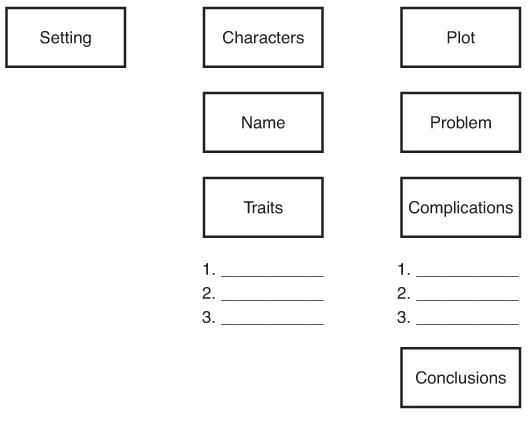Writing Well: Get Cookin'!
Get Cookin'!
When you write a short story or other narrative, you can rework an incident from your own life, come up with something completely fictional, or create a hybrid of fact and fantasy. Easier said than done, eh? Here are a few hints to get you started:
- Create the plot. Use the brainstorming techniques you learned or the plot diagrams included in this section to help you create an interesting scenario.
- Give birth to a character. Friend or foe, insider or outsider, familiar or foreign: Story ideas often start with a memorable character. Who has made an impression on you? Why? Why not use this person as the inspiration for a fictional creation?
- Jump into a setting. Sometimes a place sparks a story, so think about what a familiar place might be like at another time, a strange place at any time, or a place that holds special meaning for you.
- Get the meaning. Successful stories do more than entertain: They give us insights into the meaning of our existence. These themes reverberate long after we've put the story down. Consider building your plot around a statement about life that holds special meaning for you.

The following story chart is an enjoyable and effective way to plot your ideas:
Writer's Block
Just because something happened in real life doesn't mean that you have to include it in your plot—even if you're writing an autobiography or a narrative based on a true event. Instead, select the details and events that work toward a single effect. Remember: Art is life transformed.
Write Angles
In a fable, the theme is stated outright at the end in the form of a moral.
The earliest stories we read are fairy tales, fables, legends, and myths. You can start your own story by modeling it on a fable, such as this one by Aesop:
The Man, His Boy, and the Donkey
- A man and his son were going with their donkey to market. As they were walking along the donkey's side, a countryman passed them and said, “You fools! What is a donkey but for you to ride upon?”
- So the man put the boy on the donkey and they went on their way. But soon they passed a group of men, one of whom said, “See that lazy youngster; he lets his father walk while he rides.”
- So the man ordered his boy to get off, and got on himself. But they hadn't gone far when they passed two women, one of whom said to the other, “Shame on that lazy lout to let his poor little son trudge along.”
- Well, the man didn't know what to do, but at last he took his boy up with him on the donkey. By this time they had come to the town, and the passersby began to jeer and point at them. The man stopped and asked what they were scoffing at. The men said, “Aren't you ashamed of yourself for overloading that poor donkey of yours—you and your hulking son?”
- The man and the boy got off and tried to think what to do. They thought and they thought, till at last they cut down a pole, and tied the donkey's feet to it, and raised the pole and the donkey to their shoulders. They went alone amid the laughter of all who met them till they came to Market Bridge, when the donkey, getting one of its feet loose, kicked out and caused the boy to drop his end of the pole. In the struggle, the donkey fell over the bridge and, his forefeet being tied together, he drowned.
- “That will teach you,” said an old man who had followed them.
- Moral: Please all and you will please none.
Use the same moral (or one of your own) and create some new characters to act out the plot.

Excerpted from The Complete Idiot's Guide to Writing Well © 2000 by Laurie Rozakis, Ph.D.. All rights reserved including the right of reproduction in whole or in part in any form. Used by arrangement with Alpha Books, a member of Penguin Group (USA) Inc.
To order this book direct from the publisher, visit the Penguin USA website or call 1-800-253-6476. You can also purchase this book at Amazon.com and Barnes & Noble.
